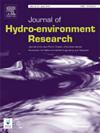Reynolds stress anisotropy with higher-order turbulence in flow through rigid emergent vegetation: An experimental study
Abstract
The flow turbulence and Reynolds stress anisotropy in flow over the smooth rigid bed with the emergent rigid vegetation in a straight channel have been experimentally investigated. Higher-order turbulence such as turbulent diffusivity, third-order moments of velocity fluctuation, quadrant analysis and flux of turbulence kinetic energy have been analysed. Reynolds stress anisotropy has been investigated by Anisotropic invariant maps (AIMs) with the use of eigenvalues for both vegetation and non-vegetation condition. In the vegetation zone, more diffusivity occurs and an apparent decrease in velocity causes larger eddies in the outer layer; whereas in the non-vegetation zone, larger eddies formation at near-bed has been found. Quadrant analysis has been done based on relative signs of velocity fluctuation which signifies that Reynolds shear stress is transported from the bed surface to the free surface when flow enters in the vegetation zone from the non-disturbed region. The longitudinal distribution of the anisotropy tensor near the bed surface for the vegetation zone provides the higher anisotropic flow than those of non-vegetation zone. Although, transverse and vertical distributions of the anisotropy tensor in the vicinity of the bed surface for the non-vegetation zone provide a lower anisotropic stream. Flow anisotropy can be understood by AIMs indicating axis-symmetric expansion in a non-vegetation zone whereas axis-symmetric contraction is in the vegetation zone. The outcomes of this study deliver a significant and detailed view of turbulent flow structures in vegetation and non-vegetation zone in an open channel flow.

 求助内容:
求助内容: 应助结果提醒方式:
应助结果提醒方式:


